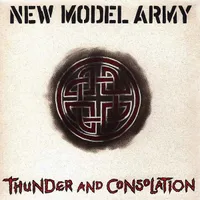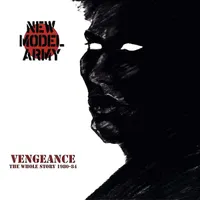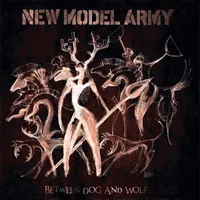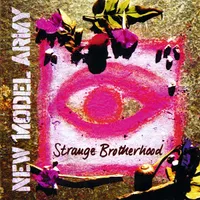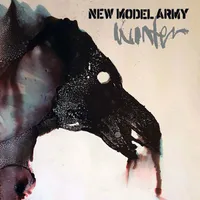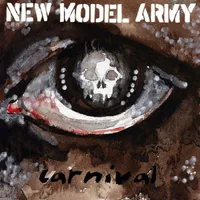The New Model Army albums you should definitely own
Mocked by most of the UK press, Bradford band New Model Army have remained as steadfastly uncompromising as they have unfashionable

New Model Army were once introduced on 80s TV show The Tube as “the ugliest band in the world”. It wasn’t meant as a compliment, although host Jools Holland had a point – with his broken teeth, scowl and general air of aggro, singer Justin Sullivan wasn’t going to win any beauty pageants.
Still, the description suited the trio. Based in unfashionable Bradford, New Model Army were the polar opposite of everything the yuppie-fied 80s had to offer – they were clog-wearing, dole-queue refugees, more likely to be found on CND marches or playing free festivals than sipping champagne and knocking back oysters in a trendy London restaurant.
Their sound was certainly primitive and direct, defined as much by the huge bass of original four-stringer Stuart Morrow as it was rock’s traditional guitar bluster. Sullivan called himself Slade The Leveller, partly in homage to a group of 13th-century Cornish insurgents, and NMA didn’t write songs so much as broadsides, taking aim at everything from Margaret Thatcher’s government to the claustrophobic mentality that turned provincial towns of Britain into battlegrounds.
They were once refused work permits by the US authorities, who said their music had “no artistic merit” – a view largely shared by the UK press, who mocked them as musical Luddites. Their fans begged to differ – the devotion NMA inspired among their followers was impressive even by the standards of the pre-internet 80s.
They’ve never shaken off that ‘Luddite’ tag, even though it misses the depth in their music. Sullivan may be a malcontent, but 1989 anthem Green And Grey is as powerful a song about wanting to escape a small town as anything Bruce Springsteen has written. Sullivan’s upbringing as a Quaker informs his work, his stridency camouflaging doubt at every turn.
Today, the singer remains the sole remaining original member of New Model Army. The band has had its share of tribulations, from the departure and death of longtime drummer Robert Heaton to the fire that destroyed the band’s studio in 200. Throughout, they’ve continued unabated and relevant, with I Did Nothing Wrong, from upcoming album Unbroken, addressing the appalling injustices of the UK Post Office Horizon scandal. The album arrives on January 26.
A few years ago, Sullivan was asked if he thought his band were a national treasure. “I’d rather be a national disgrace,” he snarled back. On that front, New Model Army continue to do an admirable job.

All the pieces were in place by the time of NMA’s second full-length album. Building on the foundations laid down by its predecessor, No Rest For The Wicked, the only thing that thunders louder than Justin Sullivan’s righteous conviction is the chiming bass that defined the band’s sound in their early years.
Fan favourite 51st State adds a scalpel-sharp folk-punk edge as it takes aim at the ‘special relationship’ between Thatcher-era Britain and Reagan-era USA, while Lovesongs’ mix of romance and regret shoots down the misguided notion that NMA were little more than clog-footed proto-crusties.
Thunder And Consolation (EMI, 1989)
New Model Army’s masterpiece: the perfect collision of folk, punk and straight-down-the-line rock. The presence of legendary producer Tom Dowd was an indication of the band’s intent to push themselves out of the pigeonhole they’d been stuffed into, an ambition that manifests in the breadth of Rob Heaton and Justin Sullivan’s songwriting.
It contains two stone-cold NMA classics in Vagabonds and Green And Grey, both given extra depth by Ed Alleyne-Johnson’s evocative violin. Elsewhere the propulsive 225 crackles with kinetic energy. As perfect an album as they’ve made.
‘I believe in justice, I believe in vengeance, I believe in getting the bastard,’ Sullivan spat on the raging title track of the band’s debut mini-album, a clarion call that marked out the band as unrepentant rabble–rousers. In fairness, it wasn’t wide of the mark. The original release’s eight tracks seethed.
Small Town England and Spirit Of The Falklands reflected the frustrations of the dole queue generation. Even the comparatively restrained A Liberal Education could barely hide its anger. They made better albums, certainly more refined ones, but it’s impossible to argue with the impact of Vengeance.
No Rest For The Wicked (EMI, 1985)
NMA came under fire from punk’s agit-prop wing for signing to EMI – a company with links to the arms trade – for their first full-length album. But having the bigger platform seemed only to focus their ire.
Sullivan took aim at xenophobia (My Country) and toxic smalltown masculinity (Better Than Them), while the furious title track remains one of their greatest anthems. But Young, Gifted And Skint possessed an underdog empathy that evoked no one so unlikely as Bruce Springsteen, in spirit if not in sound – a side of the band that remains intact today.
Their first album of the decade introduced different shades to NMA’s palette. The old thunder was present on Get Me Out, but the synth that colours The Space adds an expansive element to their sound, Before I Get Old is one of their most atmospheric songs, and Marrakesh is among their loveliest, and saddest.
That melancholy streak extends to 11 Years, whose backwards-tracked drums couldn’t mask the sorrow at the passing of time shot through it. It came along during a run of albums that threatened to take them to the next level, but the mainstream proved resistant to them. Probably for the best.
Between Dog And Wolf (Attack Attack, 2013)
NMA undeniably made their best – and most popular – albums in the 80s and early 90s. But the new millennium seemed to usher in a creative slump. After a run of holding-pattern albums in the noughties, they rediscovered their fire with Between Dog And Wolf.
According to Sullivan, this was partly down to new bassist Ceri Monger, who injected some youthful enthusiasm into the band. But it’s down to the songs too – simultaneously expansive and intimate, this is the sound of a band redrawing their own boundaries after 30 years.
The Love Of Hopeless Causes (EMI, 1993)
The closest NMA have ever come to a proper mainstream rock album: 10 muscular songs that shine with studio polish.
Of course, NMA’s idea of ‘mainstream’ is a world away from anyone else’s – lead single Here Comes The War was a semi-spoken word broadside aimed at the industrial-military complex, inspired in part by the first Gulf War, while My People takes a sideways look at populist politics, something that is even more relevant today. But the high point is Top 30 hit Living In The Rose, a hazy, uneasy love song that attempts to find joy in a vast and uncaring universe – and succeeds.
Strange Brotherhood (Attack Attack, 1998)
The mid-90s were turbulent for NMA. They split from EMI and tensions grew between Justin Sullivan and Robert Heaton. No one would have been surprised if they thought the world had moved on without them. Their response was typical NMA: dig their heels in and do what they’d always done.
The result was an album that sparks with moments of backs-against-the-wall brilliance, encapsulated in Wonderful Way To Go’s rush of death-or-glory euphoria. This would be Heaton’s last album with the band. He left soon afterwards after being diagnosed with a brain tumour and sadly died five years later.
The welcome resurgence that began with Between Dog And Wolf continued with this followup three years later. But where its predecessor was exhilarating and open, Winter bristled with a darker, more enigmatic energy. The fury and poetry was still there, but it was tempered by the wisdom of experience – opening track Beginning built its tension over seven perfectly crafted minutes.
That’s not to say they couldn’t let loose when the urge took them – Burn The Castle was an old-school call to arms that echoed the unvarnished rants of the 80s. Happily, the late-career hot streak continued with 2019's equally convincing From Here.
...and one to avoid
You can trust Louder
Carnival (Attack Attack, 2005)
There’s no such thing as a bad NMA album, but there are some humdrum ones from the 00s. Chief among them is Carnival. Opener Water promises a ride full of surprises that the album fails to deliver on. There’s little wrong with Prayer Flags, BD3 and LS43, but there’s little memorable about them either – this is NMA by numbers, the sound of a band searching for an identity after the upheaval of the late 90s.
Even here, two songs stand out. The brooding tribal rhythms of Red Earth are simultaneously weird and desolate, while closing track Fireworks Night is Sullivan’s pent-up meditation on friendship and loss, inspired by the death of ex-bandmate Rob Heaton.
Sign up below to get the latest from Classic Rock, plus exclusive special offers, direct to your inbox!
Dave Everley has been writing about and occasionally humming along to music since the early 90s. During that time, he has been Deputy Editor on Kerrang! and Classic Rock, Associate Editor on Q magazine and staff writer/tea boy on Raw, not necessarily in that order. He has written for Metal Hammer, Louder, Prog, the Observer, Select, Mojo, the Evening Standard and the totally legendary Ultrakill. He is still waiting for Billy Gibbons to send him a bottle of hot sauce he was promised several years ago.

